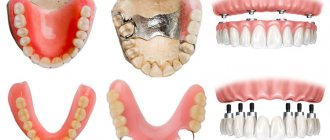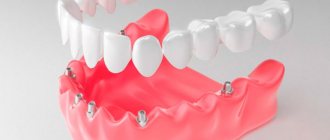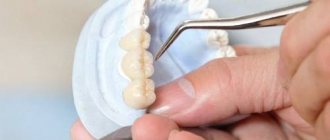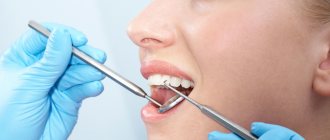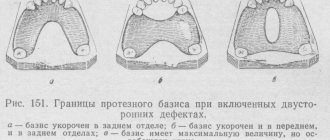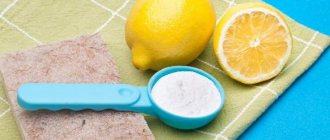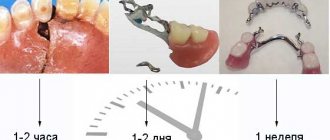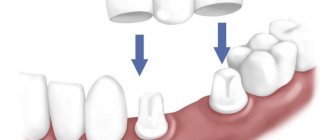Methods of dental prosthetics
Dentures are dental structures that restore the dentition or part of it. Thanks to them, the patient can chew normally, his diction and the aesthetics of his face and smile improve. Types of prostheses are distinguished according to several criteria:
- Type of fastening.
- Material.
- Manufacturing method.
- The number of teeth to be reconstructed.
On the portal Stom-Firms.ru we analyze the most common types of prostheses, removable and fixed structures, with partial and complete edentia, as well as their difference from microprostheses.
Removable types of dentures
A removable denture with a completely toothless jaw has nothing to attach to, so it is fixed to the gums using rarefied air - “on a suction cup”. This method of attachment works very well on the upper jaw, since the prosthesis easily “sucks” to the hard palate. On the lower part, due to the softness of the sublingual area, this is difficult to do. Therefore, a fixing cream is additionally used, which acts during the day.
When chewing with such a prosthesis, the entire load is transferred to the gums. This leads to the following consequences:
- The gums sag, the structure no longer fits tightly and begins to loosen. The prosthesis has to be changed every 2-3 years.
- Once the patient “chews with his gums,” he experiences pain that forces him to switch to softer foods.
Removable overdentures are made from acrylic plastic, its more hypoallergenic version Acry-free, or nylon. Nylon systems are also called flexible prostheses; they are lighter and thinner than acrylic, but due to their flexibility they hold up worse.
What are the types of dentures?
Dental prosthetics has recently reached unprecedented development, new types appear literally every year. What types of dentures are there? What advantages and disadvantages do they have?
Types of removable dentures
The most popular (if this word can be used in relation to dentures) variety are completely removable. They are popularly called “false teeth.” Such dentures are used in case of complete loss of natural teeth, or in case of loss of most of them.
Fully removable
Completely removable dentures are widely used among older people who have lost teeth as a result of age-related changes. Also, removable dental systems can be used as a temporary measure, for example, in preparation for the installation of fixed ones.
This type of prosthesis has become widespread due to its almost one hundred percent compatibility and the absence of contraindications.
There are no big differences in the design of completely removable dentures; they are all a copy of a person’s dentition with a plate that serves to secure it to the gums (the so-called denture base). How to fix the structure in the absence of teeth? The removable denture is held in the mouth using a suction cup principle.
Completely removable dentures also do not differ from each other in appearance, as they copy the natural appearance and color of healthy teeth. The differences between different types of completely removable systems are related to the material used for their manufacture.
Made of plastic
Plastic dentures are among the most affordable types of dental prosthetics. Most often, plastics based on polymerized acrylic acid are used for production, which is why plastic dental structures are also called acrylic. Artificial teeth made of ceramic or porcelain are mounted on plastic arches.
Thanks to the plasticity of acrylic, the plastic prosthesis “adjusts” its shape to the shape of the patient’s jaw within a short time, which reduces the adaptation time. Usually, a few days are enough to get used to the acrylic structure.
Unfortunately, in addition to accessibility and convenience, a plastic prosthesis based on polymerized acrylic also has a number of significant disadvantages:
- The plasticity of acrylic polymers, which makes it easier to get used to the prosthesis, at the same time makes the structure less resistant to variable loads associated with chewing food. The very principle of fastening in the mouth requires a tight fit of the prosthesis arches to the patient’s jaw protrusions; otherwise, suction is impossible. Subjected to variable loads, the plastic prosthesis becomes loose, loses its accuracy of shape and, along with it, its tightness. As a result, it may simply fall out, putting the patient in an awkward position.
- Despite all the advances in the denture industry, the aesthetics of plastic dentures still leave much to be desired. False teeth are made of plastic due to their artificiality. The base of an acrylic prosthesis is as easily distinguishable from real gum at first glance as the base of a mannequin is distinguished from living human skin.
- To produce prostheses from acrylic plastic, casting is usually used - pouring liquid plastic into molds. While the plastic is in a liquid state, microscopic bubbles form in it, which is why its surface has a porous structure. The smallest food debris is retained in the pores, serving as a habitat for microorganisms, including pathogens.
- Premature wear is not the worst thing that a user of a plastic prosthesis will have to face. The fact is that acrylic-based plastics contain a by-product of acrylic polymerization - methyl methacrylate.
- The modern chemical industry produces highly purified dental plastics, making toxic poisoning with methyl methacrylate almost impossible, but allergic reactions to this dangerous chemical may well occur. Indeed, for the development of allergies, in some cases, the body’s contact with literally several allergen molecules is sufficient.
- Due to the disadvantages described above, long-term use of plastic dentures is not recommended, and this must be taken into account when deciding which false teeth to choose. It is better to use plastic structures as temporary ones, or for short periods of time: during meals or “on the go.”
Made from nylon
Modern methods of dental prosthetics involve the use of a more advanced material - nylon - as a basis for the base. Nylon prostheses are flexible, elastic, wear-resistant. Although they are more expensive than acrylic ones, they have significant advantages over them:
- Nylon does not emit toxic substances.
- Nylon is hypoallergenic; the components included in nylon do not cause allergic reactions.
- The surface of nylon has a solid, non-porous structure, which has a beneficial effect on the hygiene of using nylon prostheses.
- Nylon has improved aesthetics; the base of a nylon dental structure looks like living gum.
Perhaps the only drawback of nylon prostheses is their higher price. However, it is worth paying attention to the following point. Unlike hard plastic structures, nylon cannot distribute the chewing load evenly. Constant chewing on one side leads to gum inflammation and bone atrophy.
A nylon denture cannot distribute the force across the entire jaw area, so you will have to take on this work yourself. When using a nylon denture, be sure to alternate sides when chewing.
Types of partial dentures
Completely removable dental structures that use the principle of suction cups to hold them in the mouth, regardless of the material of manufacture, have a serious drawback - unreliable fixation in the oral cavity. Therefore, dentists, whenever possible, look for a fulcrum in the patient’s mouth with which to reliably strengthen the prosthesis. This “fulcrum” is the patient’s preserved natural teeth. Systems fixed by attachment to natural teeth are called partial dentures.
Partially removable dental systems are also made from acrylic plastics or nylon, so they have all the advantages and disadvantages inherent in these materials. But unlike removable dentures, partially removable dentures can differ quite seriously in design.
Based on their design, partially removable dentures are divided into groups:
- Bugelnye.
- One-sided partially removable.
- Immediate dentures.
- Conditionally removable.
For all types of partially removable dentures, a classification by type of fixation device is also used.
Types of clasp dentures
Clasp dentures are rightfully considered the most advanced among partially removable ones. This is one of the best methods of dental prosthetics. The principle of their operation is based on the principle of load redistribution using arc elements (“clasp” means “arc”). This achieves both delayed wear of the structure and the absence of increased local loads on the tissues and bones of the jaw.
According to the method of fixation, clasp structures are divided into prostheses:
- With clasps.
- On micro locks.
- On telescopic crowns.
With clasps
All partial dentures are fixed in the patient's mouth by attaching to healthy teeth. One of the options for devices for such connection are clasps. Clasps are metal devices that, due to their special shape, reliably cover a healthy tooth, fixing the structure. The main advantage of this fixation option is that it does not require any manipulation of healthy teeth. Unfortunately, such designs have a significant drawback, which, although it does not affect the health of the owner, can cause some inconvenience. The disadvantage is that metal clasps are very visible when talking. Because of this, many are embarrassed to wear dentures with clasps and prefer systems with attachments.
On attachments (on micro-locks)
Retention devices built into a dental crown that fits over a healthy tooth. The second part of such a device is fixed on the prosthesis. The two parts of the attachment are connected like a lock, and the entire structure is securely fixed. The attachments are made in such a way that when the prosthesis is in the mouth, all “unnatural” parts of the structure are securely hidden from the eyes of an outside observer.
On telescopic crowns
They are one of the options for installing an attachment. The crown in which the attachment is mounted is not placed on the tooth, but on a permanently installed crown on the tooth. In this case, one crown fits into the other, like parts of a retractable spyglass. This design is necessary in the case of prosthetics for a large number of teeth to improve the reliability of fixation.
Single-sided partially removable
There is no doubt that clasp structures are convenient and reliable, but, unfortunately, they are not always applicable. After all, their design is based on an arch, and the arch obviously needs two points of support, so it is advisable to use clasps when making prosthetics on both sides of the jaw at once. What to do in this case? There are modern methods of prosthetics for teeth located on one side of the jaw.
- Plate dentures are one or more ceramic artificial teeth on a nylon or acrylic plastic base. The structure rests on the gum and is fixed to adjacent teeth with metal clasps.
- Dental segments differ fundamentally little from plate structures, but are designed to replace a larger number of teeth. Tooth segments are usually fixed with attachments on conventional or telescopic crowns, since fixation with clasps is not reliable enough for them.
Immediate dentures
In their structure, immediate dentures resemble clasp dentures, lacking the clasp itself, that is, the arch. These are simple and inexpensive designs used only as a temporary measure while awaiting the manufacture of a permanent removable prosthesis or surgery to implant a fixed prosthesis. For fastening, simple fixation is used to two adjacent teeth using acrylic clasps or suction cups. There are two main types of immediate dentures:
- Full . They are designed to completely replace, albeit for a short time, a lost tooth in all its functions. That is, with such a prosthesis you can fully chew moderately solid food.
- Partial . They are intended more to perform a “representative function”, to protect exposed gums from inflammation and damage, as well as to prevent healthy teeth from shifting to the place of removed ones. When using this type of temporary structures, it is recommended to consume only liquid and semi-liquid food or relatively solid food that does not require chewing effort (sausages, except hard smoked sausages, well-stewed meat, chopped cutlets, etc.).
Conditionally removable
Conditionally removable are small structures that usually replace one lost tooth. There are two types:
- A conditionally removable denture with clasps is attached to adjacent teeth using metal fixing devices.
- Bonded conditionally removable prosthesis. The specificity of prosthetics for an individual tooth allows the structure to be fixed with special dental glue.
There is no need to regularly remove such a prosthesis, and in the case of installation with glue it is generally difficult, which is why they are called conditionally removable.
Types of permanent (fixed) dentures
Without exception, all types of removable dental structures have such disadvantages as a decrease in the quality of fixation over time, clogging of food particles under the denture, and unnatural loads when chewing. If you want to avoid these inconveniences, then you may want to opt for fixed, permanent dentures. What types of permanent dentures are there?
- Implants.
- Dental bridges.
- Microprostheses.
Types of implants
The use of dental implants is the most radical method of dental prosthetics. The implant is placed directly into the patient's jaw (bone or gum) and serves as a base for an artificial tooth.
Chemically inactive, highly resistant alloys made from various high-strength metals are used as materials for the manufacture of implants.
- Root-shaped implants are the most physiological and natural form of prosthetics. A root-shaped implant is made in the form of a tooth root and is installed in its place.
- Plate implants are used if the installation of a root-shaped implant is impossible due to destruction of the periosteum of the jaw in the event of injury or illness. A plate is implanted into the jaw, which has a better degree of fixation due to its larger area.
- Basal implants are used in cases of severe damage to the jaw. In design, they resemble plate ones, but are installed at a greater depth - into the jaw bone.
- Submucosal implants , as their name suggests, are placed under the mucous membrane of the gums. They are usually used to install dentures for front teeth that do not experience heavy chewing loads.
Types of bridges
Bridges or dental bridges are dentures that replace a number of adjacent teeth and, like a bridge, have two or more points of support. What types of dental bridges are there?
- Implant-supported dental bridges are supported by two, rarely three, intramaxillary implants. Such prosthetics are used in cases of complete loss of a number of chewing teeth.
- Dental bridges on crowns. If implantation is not possible for one reason or another, healthy teeth can be used as bridge supports by placing crowns on them. The disadvantage of this method is damage to healthy teeth during the grinding process to install crowns.
- Crown bridges. If adjacent teeth are not completely lost, but are severely damaged, then they can not be removed, but used as a support for a bridge. A number of teeth are ground down and one large crown-bridge is placed on them.
Types of microprostheses
- Dental crowns are the most common type of microprosthesis. Crowns are used if the base of the tooth is preserved and can serve as the basis for a prosthesis. The crown is placed on the so-called dental stump - a specially ground outer part of the tooth. The materials used for making crowns are metal-ceramics, porcelain, stainless steel and titanium alloys. Aesthetic crowns are also made from precious metals, often inlaid with precious stones.
- Veneers . Veneers are thin plates made from a tooth impression and placed on the outer, visible side of the dentition. Made from porcelain and composite materials. They can serve to protect the tooth, but usually play a purely aesthetic role. They gained wide popularity among politicians, actors, theater and film workers.
- Dental inlays are a compromise between a filling and a crown. They are used when there is significant damage to the tooth, in which it is difficult to install a filling, but it is still possible to save part of the tooth without culturing. The inlay is usually made of ceramic based on a cast of a tooth that is symmetrical to the one being prosthetized.
Which ones to choose?
As you can see, the range of types of prosthetics offered by modern dentistry is huge, making a choice on your own is not easy.
It should be understood that there is no clear answer to the question of how best to make dental prosthetics; each type has its own goals. The financial capabilities of the patient also play a significant role.
Some types are used for complete tooth loss (implants, clasp dentures), others for partial loss (crowns, inlays), and others are designed to improve the appearance of the “facade” of the dentition (veneers).
The advice of a qualified dentist will help you make a choice in favor of the best dental prosthetics, the best one specifically for you.
Fixed and conditionally removable types of prostheses
The most reliable way to hold a denture on a toothless jaw is on implants. From 2-3 to 6-8 pins are implanted into the jaw, to which the structure is attached. Some systems can be removed independently, others only in a doctor’s office:
- In the first case, push-button or beam fixation is used. The prosthesis is called conditionally removable, since it can only be removed with force. You can even sleep with them. Sometimes the patient’s old removable denture is placed on the implants, which significantly reduces the cost of treatment.
- Completely fixed prosthetics on implants are the most reliable. Such a prosthesis does not fall out of the mouth, does not feel like a foreign body and looks like your own teeth. And since the chewing load is transferred to the implants, there is no bone tissue atrophy.
Artificial teeth are made of acrylic or ceramic; they follow the shape of the dentition and parts of the gums. The product is very durable and will last 20 years.
Fixed prosthetics are carried out using a two-stage implantation technique, which takes 3-8 months, or according to protocols with immediate loading. Methods such as All-on-6 and All-on-4 allow you to set teeth in a few days.
Removable
Removable dentures are structures that are not intended for permanent wear. They need to be removed periodically for sleep, rest and to care for them.
Indications for use:
- if the jaw is completely devoid of teeth;
- removal of more than 6 teeth in a row on one side of the jaw;
- absence of chewing teeth on one or both jaws;
- temporary replacement of lost teeth in the preparatory period for the installation of fixed dentures.
In all these cases, a removable denture allows you to restore the chewing function of the dentition and eliminates pronounced cosmetic imperfections of the oral cavity.
Depending on the design features, dentures can be:
- completely removable;
- partially removable.
Fully removable dentures
Removable dentures are an affordable design that does not require surgical intervention during installation. They are used if the natural teeth of the oral cavity are completely absent or have lost their functionality and must be removed.
Externally, the prosthesis is an anatomically curved plate in the shape of the gum and palate (for the upper jaw). It is devoid of special fasteners and is fixed due to the suction effect of the gums.
Completely removable dentures cope with their main task and have the most affordable cost, however, they are characterized by a number of limitations and disadvantages:
- unstable contact with the jaw;
- complex adaptation process;
- painful sensations with a slight increase in the load on the jaw;
- restrictions on eating a certain type of food (hard and requiring thorough chewing);
- impaired diction, discomfort when coughing, laughing;
- the need for systematic care;
- gradual thinning of gum tissue and jawbone;
- the need for regular dental examinations;
- rapid wear of the prosthesis.
Partially removable
They are used if there are still healthy teeth in the oral cavity. A partial denture can be worn permanently or as a temporary measure in preparation for further dental procedures.
This is the most affordable solution, especially if fixed prosthetics services are not recommended or are not available to the patient.
There are several options for partially removable dentures.
- Plate denture - similar in structure to completely removable dentures, but is used in the absence of several chewing teeth. The lack of suction effect of the gums is compensated by the presence of special hooks (clasps) with which the dentures are attached to healthy teeth. There are plastic, acrylic and nylon options.
- Immedia prosthetics - play the role of temporary correctors of the dentition when preparing the mouth for permanent prosthetics. They are usually made from softer materials (for example, nylon) and are not designed to last a long time.
- One-sided prosthesis - differs from plate ones in one-sided design; used when one or more teeth are missing on one side.
- Clasp dentures are high-tech and durable structures with optimal load redistribution throughout the jaw due to the built-in metal arch frame. Recently, metal-free clasp models with elastic clasps have begun to appear, which avoids preliminary grinding of the supporting teeth. Unlike other types of partially removable dentures, clasp dentures do not require removal at night, so they are much more convenient for everyday use.
On a note! The bulk of prostheses are made of plastic, but there are also softer models made of nylon. They are held in the mouth due to the elastic properties of the material itself and are more suitable for unilateral and temporary dentures. However, nylon dentures are less wear-resistant and have a characteristic springing effect when chewing.
Types of dentures for partial edentia
If there are teeth that can not be removed, they are used as supporting teeth. To do this, they are strengthened: they are ground and a crown is put on.
Removable partial dentures
The material for prosthetics is the same acrylic, Acry-free or nylon, and a system of clasps - staples that cling to the supporting teeth - is used as retainers. When you get into the smile zone, metal clasps are noticeable, but if you make them from nylon, the aesthetics are preserved.
The best option for partial removable dentures is clasp dentures. The base in it is a metal arc in the shape of the gum, on which acrylic or nylon crowns are located. Most often, the system is fixed using clasps and micro-locks-attachments. Half of such a lock is immersed in the body of the system, and the second is installed on the supporting tooth. Micro-locks even allow you to sleep in a prosthesis.
Classification of dentures
There is a large classification of dentures.
They are divided into the following types:
Removable partial denture
This design can be used if part of the teeth are missing, but normal healthy teeth are also present. Partial dentures can be used for certain dental procedures.
It is made quickly and from solid acrylic with metal. Because of this, the plastic prosthesis is the most inconvenient and causes discomfort, although it is very cheap. The load during chewing is applied evenly to the bone tissue.
Removable partial denture
Elements that imitate teeth are attached to curved plates. Allergic reactions are possible. Taste sensations may be impaired and diction may change. This can include gum disease, and the enamel wears away where there is contact with your own teeth. It can take six months to get used to the design.
It is important to always rinse with water after eating to ensure no food remains. Brush and toothpaste 2 times a day.
Removable complete denture
It has suction cups, which eliminates the feeling of discomfort during installation and wearing. It is used in cases of complete absence of teeth.
This design is poorly resistant to chewing loads and has an unaesthetic appearance. They can last no more than 5 years.
Removable complete denture
If a bone tissue defect is detected, the structure is replaced earlier.
Types of complete dentures are classified according to the base, which can be acrylic or nylon. And the teeth themselves are often made of plastic.
Prosthetics with yokes
They are considered one of the most durable and quite good-looking prostheses. It is possible to replace one or more teeth.
When a person chews, the load goes to the entire cavity. The shortest period of adaptation.
Prosthetics with yokes
In this case, there are three types of fixation:
- Device using clasps - metal hooks;
- Fastening using attachments – mini-locks;
- Installation on telescopic crowns. Primary ones are installed on implanted implants, and secondary ones on removable dentures. This helps to firmly fix the structure in the mouth.
Nylon prosthesis
It is made similarly to plastic, but the material has its advantages. Nylon and silicone are elastic and lightweight, making it easy to leave overnight.
Nylon prosthesis
Very convenient, but there is a possibility of deformation, which will lead to injuries at the attachment points. These prostheses are expensive and cannot be repaired.
Telescopic prosthesis
It is the most comfortable type of removable prosthetics. The joining of composite structures is similar to the design principle of a telescope.
The telescopic device is installed either on existing teeth or on implants.
A non-removable cap made of metal is attached to the abutment tooth. The removable part of the denture is attached to the supporting teeth. It can be easily removed if necessary.
Telescopic prosthesis
The advantage is that they can be corrected in case of loss of other teeth. During manufacturing, it is very important not to deviate anywhere from the manufacturing technology. Cheap materials can also affect the results.
Dental crowns
They protect dead teeth from further decay. The disadvantages of such fastening are the injury to healthy teeth if they need to be used as supports. When choosing a crown, the wishes of the patient and his financial situation are taken into account.
Modern dentures consist of the following materials: metal ceramics, zirconium oxide, porcelain, ceramics, metal alloys and other materials to which people have minimal allergic reactions.
Metal-ceramic dental crowns consist of a metal frame lined with ceramics. This gives strength and good appearance, but as the gums recede, the metal rim of the crown is visible.
Types of dental crowns
Metal-ceramic crowns can also be placed on teeth with an existing nerve. There are crowns made purely from ceramics, they look even better and have a long service life, especially since they are biocompatible with tooth tissues. Metal ones are considered the most unaesthetic.
An impression of both jaws is taken to accurately create the crown. And based on the impression, a plaster model is cast in the laboratory, on which a wax sample of the future crown is modeled.
Dental bridges
This system is made for constant wear. It consists of several crowns, and artificial teeth are located in the center. The bridge is installed on 1-3 teeth, in rare cases on 4.
To secure this structure, adjacent teeth are ground down and crowns are attached to them. To do this, the teeth are completely healed so that they can withstand strong chewing pressure.
Dental bridge
The shape and appearance are as close as possible to real teeth.
They are also made from different materials:
- metal;
- metal ceramics;
- solid ceramics;
- plastic;
- metal-plastic.
Bridge prostheses are produced in three ways - solid, stamped and adhesive.
Prosthetics using veneers
These microprostheses can restore the color and shape of one or more teeth. They are used to restore front teeth that have large defects or cannot be whitened.
Ceramic and porcelain veneers are mainly used. The thickness of the plates is approximately 0.2-0.5 mm.
Prosthetics with ceramic or composite inlays
Inlays are fragments that replace only the destroyed part and give the tooth its original appearance. They are used when a filling can no longer help, but the teeth can still serve.
The dental inlay is fixed using special cement. Then it is polished and given the desired shape and appearance. Inlays are made for crowns when the crown is in poor condition, but the root is still good.
Prosthetics using veneers
Ceramic and composite inlays are closest to natural teeth. Ceramic ones are identical to porcelain ones and are often used on the front teeth. Composite inlays are more expensive than fillings, but are in no way inferior to them.
Dentures with implants
Replaces removable dentures in complete absence of teeth. In this case, an implant is implanted in each place of a previously existing tooth. About 28 units are implanted on both jaws, to which the crown is fixed.
But this technique is only allowed for those who have sufficient bone tissue.
They make bridge-like implants, All-on-4 (4 implants at an angle of 45˚) and removable.
Conclusion
Contact good specialists so that the prosthesis does not cause discomfort and does not bring unnecessary consequences.
But no matter what kind of prosthetics is chosen, it is very important to take care of the structure for a longer service life.
Fixed partial dentures
Permanent prostheses - bridges - consist of a series of crowns welded together. They are fixed in two ways: classical and using adhesion - gluing:
- In a classic bridge there are 2-3 more units than there are missing teeth. The “extra” outer ones are put on the supporting teeth. With quality care, the system will last from 5 to 15 years.
- An adhesive bridge consists only of crowns that replace lost ones. Legs extend from it in both directions, which are glued to the neighboring supporting ones. This is a more gentle method of prosthetics, but also less durable; it will have to be changed in less than 3 years.
The most reliable way, although more expensive, is to secure the bridge to implants.
Types of dentures in the absence of 1-2 teeth
If 1-2 teeth are missing in a row, the doctor may offer the following options for their reconstruction:
- A crown placed on an implant.
- A bridge with fixation on adjacent teeth, which are then ground down for crowns.
- Nylon or acrylic butterfly prosthesis: a piece of artificial gum around it looks like butterfly wings, which cover nearby teeth. It can be either a temporary solution while the implant takes root, or for permanent wear if it is necessary to reduce interventions to a minimum.
Single dentures - crowns - are also installed on the stump of a tooth or a pin in its root.
Microprostheses
Microprosthetics is used when there is a tooth, but its upper part is severely damaged. To restore it, use inlays and onlays.
Inlays are essentially individual large fillings that are made in a laboratory based on an impression. They are characterized by high strength and a longer service life compared to conventional fillings.
Veneers and thinner ones - lumineers - are ceramic plates that are attached to the outside of the teeth. Their main purpose is aesthetic, although they protect the front of the enamel from further damage. Overlays are used to correct stains, cracks, bends and wide crevices. Service life is about 10 years.
General recommendations for choosing a prosthesis
Almost any dental defect can be restored using several methods. What matters is the condition of the body as a whole, the characteristics of the oral cavity and the method of prosthetics that the clinic works with. If you are not financially limited, listen to your doctor's recommendations: they are based on sufficient experience.
When looking through reviews and choosing a place of treatment, pay attention to the length of the warranty period. This will allow you to calculate the time of wearing the prosthesis.
Other useful sections on the topic
Look at these pages to decide on the type of prosthesis and its cost:
- Removable prosthetics
- Fixed prosthetics
- Prosthesis on implants
- Basal implantation for prosthetics
Literature used for the article:
- Orthopedic dentistry / A.S. Shcherbakov, E.I. Gavrilov, V.N. Trezubov, E.N. Zhulev - St. Petersburg: IKF "Foliant", 2015.
- Removable dentures: textbook / M.L. Mironov. - M.: GEOTAR-Media, 2014.
- Materials and technologies in orthopedic dentistry: Textbook / A.I. Abdurakhmanov, O.R. Kurbanov. - Medicine - M., 2014.
Author of the article: Natalya Aleksandrovna Kozlova
Copywriter of the information portal Stom-Firms.ru. Specializes in medical and dental texts.
What does a complete denture consist of: - base (plates made of plastic and metal that repeat the relief surface of the underlying mucous membrane and the lateral surfaces of the teeth on which they are applied); - artificial teeth (Teeth used on complete and partial removable dentures are manufactured at the factory in the form of standard sets of various shapes and colors. They are plastic and porcelain) Complete removable dentures rest on the toothless alveolar processes of the jaws and palate and distribute the chewing load of missing teeth onto these parts of the masticatory apparatus. The material used to make complete dentures is non-toxic and feels natural in the mouth. These are acrylic dental resins. The formation of a prosthesis from this material occurs by injection molding or using compression polymerization. Using the latest advanced achievements in the production of composite plastics, artificial teeth made using modern technologies have very high wear resistance and aesthetic appearance. All these conditions create the prerequisites for achieving the maximum individual aesthetic effect and long-term reliability of the structure during the manufacturing of prostheses. By the way, for reference, if you remember the notorious glass of water, then modern plastics do not require nightly water procedures at all. This firmly rooted belief has been preserved among the people since the time of “William II” when the base (base) of the prosthesis was made of natural rubber. And since rubber products in the air were subjected to rapid oxidation, followed by drying out, cracking and loss of elasticity, it was proposed to arrange water baths for the prostheses, especially since it was almost impossible to keep the rubber clean and hygienic for a long time. Modern plastic products, when used correctly, with good hygiene and subject to the correct manufacturing processes, do not change their appearance, color, density and strength for a very long time. So, it is quite acceptable to leave complete removable dentures, as well as other removable orthopedic products, in the oral cavity overnight after an evening hygienic soak. If the owner of a removable orthopedic structure just wants to rest at night from the presence of the prosthesis in the mouth, then after hygienic cleaning, the prosthesis is wiped dry and, wrapped in a napkin or handkerchief, left in the right place awaiting the next “working day.” The patient and dentist today have a huge choice regarding the color and shape of the teeth on a removable denture, and this allows you to make the most natural denture that will not cause complexes for the owner. For complete removable dentures, there are entire sets of dental arches made of high-quality plastic, and therefore, when making a denture, there are no difficulties with grinding, selecting and installing teeth. It would probably be superfluous to say that in the manufacture and fitting of such a prosthesis, the wishes of the patient and his individual characteristics must be taken into account. All existing types of removable dentures differ from permanently fixed bridges in that they must be removed independently, since they lie on the gingival surface of the jaw and thereby create poorly washed areas. Dentures must be removed periodically after eating in order to rinse the inner plastic surface of the denture base adjacent to the gum. The oral cavity is also rinsed, after which the denture is returned to its place until the next meal or before evening or morning hygiene procedures and teeth brushing. There are some points that are important for owners of complete dentures. Naturally, viscous substances, in particular chewing gum, should be avoided, as they can break the denture. You should also be careful when eating solid foods, at least initially, until your dentures have settled in. It is better to chop the food and eat it in this form, but do not bite off or chew hard pieces - there is a risk of breaking the denture. Returning to the ethical side of the matter, it is also necessary to note that all manipulations and hygienic procedures in one way or another associated with removable dentures are carried out by their owners alone in the bathroom and in no way can serve as any constraining circumstance and, moreover, a biased attitude towards reluctance to use dentures. Removable dentures do not necessarily need to be removed at night, and modern technical capabilities make it possible to produce such comfortable and aesthetic products that not only outside observers, but at first the owners of partial dentures themselves do not quite understand which teeth are being removed. The ability to use locking fasteners makes the dentures easy to use, very securely held in the oral cavity, and such dentures do not create any uncomfortable situations. Of course, teeth, and especially artificial ones, must be brushed after every meal, but this is not always possible for a number of reasons. As a rule, the most inexpensive ones are used for the manufacture of partial removable dentures - acrylic sets (sets) of teeth. It is impossible to efficiently produce this prosthesis in an occluder (a primitive and outdated device).
Back to list of articles
